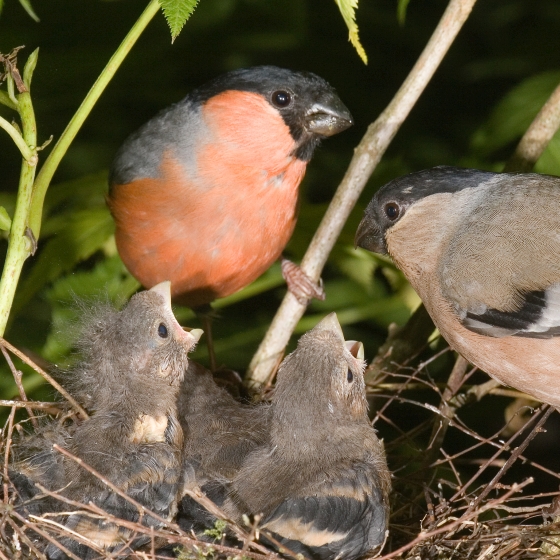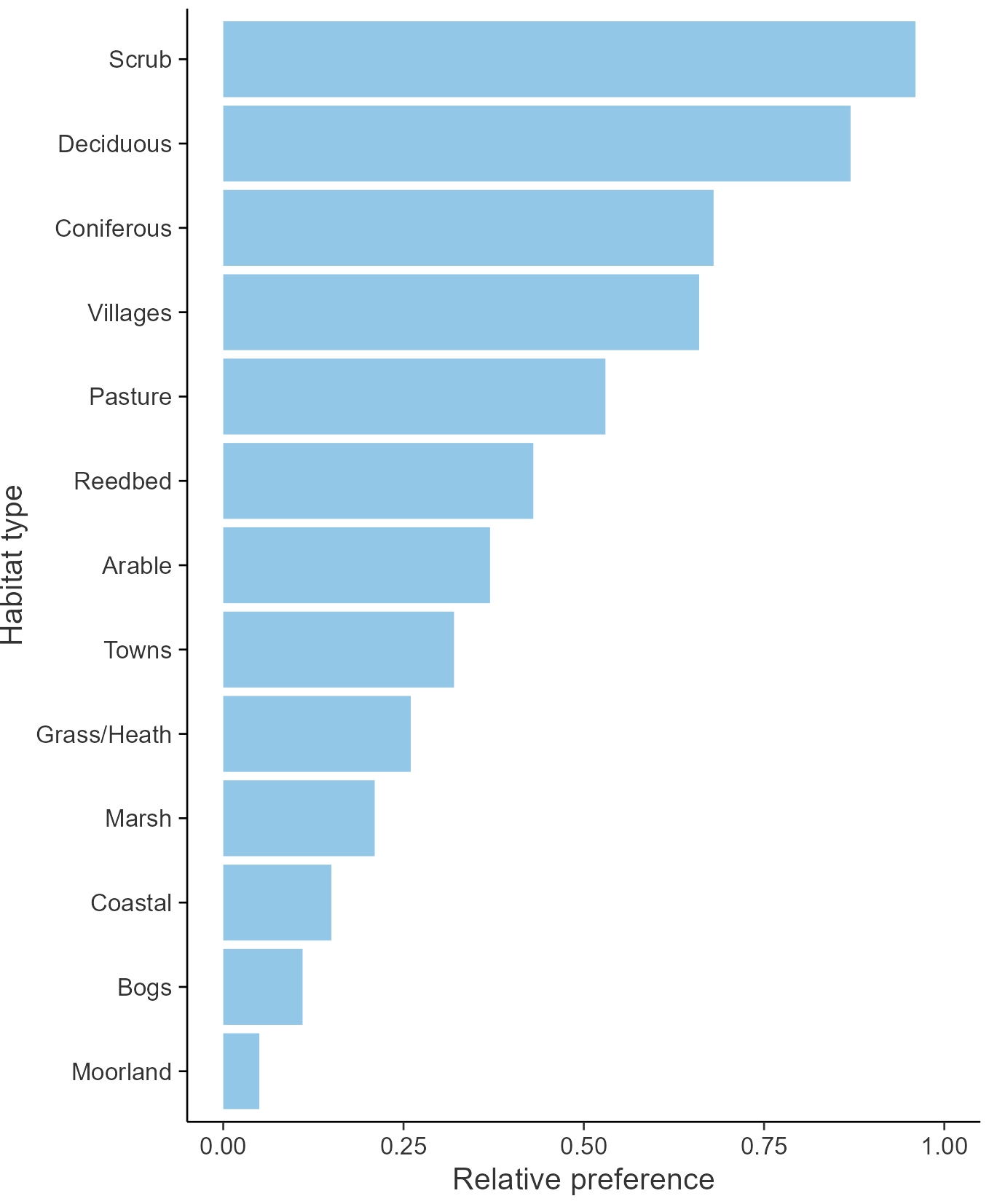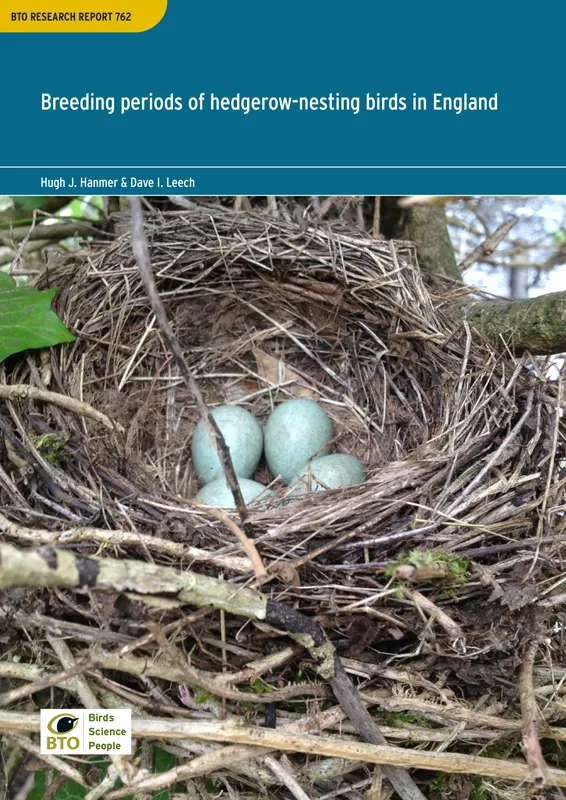Bullfinch

Introduction
A fairly sedentary resident species, the Bullfinch is distributed widely across Britain & Ireland. The highest densities of this lovely bird are found in lowland wooded landscapes.
The male has a striking bright pink breast and neck, contrasting with a smart black cap. The females are duller, but still highly attractive birds. Bullfinches can often be seen at garden bird feeders, and in spring they will visit garden fruit trees to nibble the buds. Their call is a soft single whistle.
There was a steep decline in UK Bullfinch numbers at the end of the 1970s and, though there has been an upturn in the fortunes of this species more recently, the population is still around 40% lower than in the 1960s. It may be that declining habitat quality and decreasing numbers of large orchards are impacting the population.
- Our Trends Explorer gives you the latest insight into how this species' population is changing.

Key Stats
Identification
Songs and Calls
Song:
Call:
Alarm call:
Flight call:
Begging call:
Status and Trends
Conservation Status
Population Change
The UK Bullfinch population entered a long period of decline in the mid 1970s, following a period of relative stability. The decline was initially very steep, and more so in farmland than in wooded habitats, but became shallower and eventually ended around 2000, since when there has been some increase. CES and CBC/BBS both suggest there are large annual fluctuations around the overall long-term trend. The BBS map of change in relative density between 1994-96 and 2007-09 indicates that major decreases in southern and western parts of the UK over that period contrasted with increases in northern England and eastern Scotland. There has been a decline across Europe since 1980 (PECBMS: PECBMS 2020a>). The UK conservation listing was downgraded from red to amber in 2009 (Eaton et al. 2009).
Distribution
Bullfinches are relatively sedentary in Britain & Ireland, with a wide distribution. Densities are highest in lowland wooded landscapes, particularly in Ireland, and lowest in large conurbations and in upland areas. Bullfinches are absent from open country with few trees, such as around the Wash, in exposed coastal regions in western Ireland, and on many Scottish islands.
Occupied 10-km squares in UK
or view it on Bird Atlas Mapstore.
or view it on Bird Atlas Mapstore.
European Distribution Map
Distribution Change
Overall breeding range size has changed little since the 1968–72 Breeding Atlas but this conceals a mix of gains and losses. There have been recent gains in western Ireland, on some Inner Hebridean islands and in northern and western Scotland; some of these may reflect an increase in tree planting in these exposed locations. Losses are associated mostly with upland edges or with coastal areas.
Change in occupied 10-km squares in the UK
or view it on Bird Atlas Mapstore.
or view it on Bird Atlas Mapstore.
Seasonality
Bullfinch is recorded throughout the year on up to 20% of complete lists.
Weekly pattern of occurrence
The graph shows when the species is present in the UK, with taller bars indicating a higher likelihood of encountering the species in appropriate regions and habitats.

Habitats
Breeding season habitats
Relative frequency by habitat
The graph shows the habitats occupied in the breeding season, with the most utilised habitats shown at the top. Bars of similar size indicate the species is equally likely to be recorded in those habitats.

Movement
Britain & Ireland movement
Foreign locations of birds ringed or recovered in Britain & Ireland
Dots show the foreign destinations of birds ringed in Britain & Ireland, and the origins of birds ringed overseas that were subsequently recaptured, resighted or found dead in Britain & Ireland. Dot colours indicate the time of year that the species was present at the location.
- Winter (Nov-Feb)
- Spring (Mar-Apr)
- Summer (May-Jul)
- Autumn (Aug-Oct)

European movements
EuroBirdPortal uses birdwatcher's records, such as those logged in BirdTrack to map the flows of birds as they arrive and depart Europe. See maps for this species here.
The Eurasian-African Migration Atlas shows movements of individual birds ringed or recovered in Europe. See maps for this species here.
Biology
Productivity and Nesting
Nesting timing
Egg measurements
Clutch Size
Incubation
Fledging
Survival and Longevity
Survival is shown as the proportion of birds surviving from one year to the next and is derived from bird ringing data. It can also be used to estimate how long birds typically live.
View number ringed each year in the Online Ringing Report.
lifespan
Survival of adults
Survival of juveniles
Biometrics
Wing length and body weights are from live birds (source).
Wing length
Body weight
Ring Size
Classification, names and codes
Classification and Codes
- Order: Passeriformes
- Family: Fringillidae
- Scientific name: Pyrrhula pyrrhula
- Authority: Linnaeus, 1758
- BTO 2-letter code: BF
- BTO 5-letter code: BULLF
- Euring code number: 17100
Alternate species names
- Catalan: pinsà borroner eurasiàtic
- Czech: hýl obecný
- Danish: Dompap
- Dutch: Goudvink
- Estonian: leevike
- Finnish: punatulkku
- French: Bouvreuil pivoine
- Gaelic: Corcan-coille
- German: Gimpel
- Hungarian: süvölto
- Icelandic: Dómpápi
- Irish: Corcrán Coille
- Italian: Ciuffolotto
- Latvian: svilpis, smilgis
- Lithuanian: juodagalve sniegena
- Norwegian: Dompap
- Polish: gil (zwyczajny)
- Portuguese: dom-fafe
- Slovak: hýl obycajný
- Slovenian: kalin
- Spanish: Camachuelo común
- Swedish: domherre
- Welsh: Coch y Berllan
- English folkname(s): Alp, Nope
Research
Causes of Change and Solutions
Causes of change
The reasons for the decline of Bullfinch are unclear, although a recent study suggests that changes in adult survival might be important. Agricultural intensification is suspected to have played a part in the decline but other factors may also have contributed
Further information on causes of change
The demographic mechanism of decline remains unclear (Siriwardena et al. 1999, 2000b, 2001a), although a more recent study suggests that changes in adult survival may be important (Robinson et al. 2014). Agricultural intensification and a reduction in the structural and floristic diversity of woodland are suspected to have played a part through losses of food resources and nesting cover (Fuller et al. 2005). Alongside these factors, Proffitt et al. (2004) and Marquiss (2007) mention the constraints on survival outside the breeding season and the possible role of higher Sparrowhawk numbers on the ability of Bullfinches to exploit resources in some habitats. There have not been any significant changes to brood and clutch sizes or to nest failure rates.
Information about conservation actions
The reasons for the decline of this species are unclear and no clear links to environmental and land use changes in farmland have been identified, hence it is uncertain whether management actions and agri-environment options aimed at many other farmland species will benefit this species. Management of hedgerows and woodland understorey vegetation to provide habitat for may be important, but further work is required to identify specific habitat requirements so that more specific conservation actions can be tested and recommended.
Publications (2)
Breeding periods of hedgerow-nesting birds in England
Author: Hanmer, H.J. & Leech, D.I.
Published: Spring 2024
Hedgerows form an important semi-natural habitat for birds and other wildlife in English farmland landscapes, in addition to providing other benefits to farming. Hedgerows are currently maintained through annual or multi-annual cutting cycles, the timing of which could have consequences for hedgerow-breeding birds.The aim of this report is to assess the impacts on nesting birds should the duration of the management period be changed, by quantifying the length of the current breeding season for 15 species of songbird likely to nest in farmland hedges. These species are Blackbird, Blackcap, Bullfinch, Chaffinch, Dunnock, Garden Warbler, Goldfinch, Greenfinch, Linnet, Long-tailed Tit, Robin, Song Thrush, Whitethroat, Wren and Yellowhammer.
05.03.24
Reports Research reports

Birds of Conservation Concern Wales 4: the population status of birds in Wales
Author: Johnstone, I.G., Hughes, J., Balmer, D.E., Brenchley, A., Facey, R.J., Lindley, P.J., Noble, D.G. & Taylor, R.C.
Published: 2022
The latest review of the conservation status of birds in Wales. The report assessed all 220 bird species which regularly occur in Wales. There are now 60 species of bird on the Red List, with 91 on the Amber List and just 69 - less than a third of the total number of species - on the Green List.
06.12.22
Reports Birds of Conservation Concern


